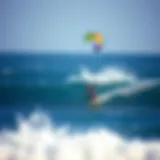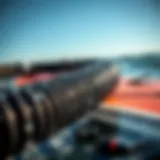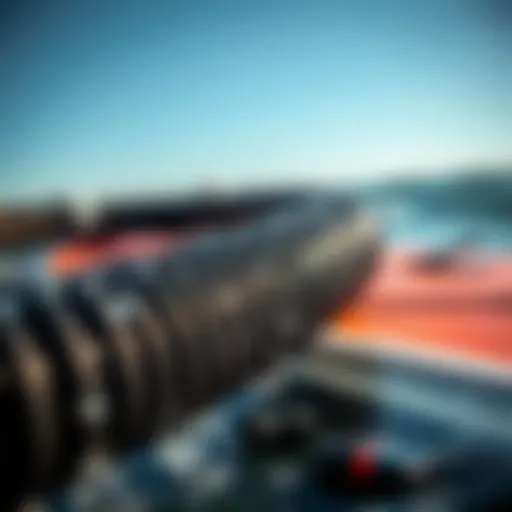Exploring the Flight Board Efoil for Kiteboarding


Intro
The world of water sports is ever-evolving, with new technologies reshaping how enthusiasts interact with the elements. One of the standout innovations that has captured the attention of kiteboarding aficionados is the flight board efoil. This futuristic piece of equipment not only enhances the kiteboarding experience but also redefines it. As kiteboarding enthusiasts, understanding the intricacies of the efoil becomes essential for unlocking its full potential on the water.
In this guide, we will explore the various dimensions of the flight board efoil, including its design features, operational principles, pros and cons, and key maintenance tips. This thorough examination is crafted for kiteboarders—whether you're just starting out or you’ve been riding waves for years—looking to expand your skills and operational knowledge in this rapidly changing landscape.
So, let’s dive into the techniques that can elevate your kiteboarding experience to new heights with the flight board efoil.
Prelude to Efoiling
Efoiling is making quite the splash in the world of water sports, especially amongst kiteboarding enthusiasts. This innovative riding experience is more than just a trend; it represents a significant evolution in the way we interact with water. Understanding efoiling isn’t just for the tech-savvy; it’s essential for anyone looking to explore new boundaries in kiteboarding. This section will delve into the fundamentals of efoiling, tracing its history and defining its capabilities, all while highlighting why every kiteboarder should take note.
Defining Efoiling
So, what exactly is efoiling? At its core, efoiling involves riding a board that's lifted above the water surface by a hydrofoil, all while powered by an electric motor. Unlike traditional kiteboarding, where you rely on the wind to provide power, efoiling offers the freedom to glide smoothly across water, regardless of wind conditions.
This unique aspect allows users to experience a sense of flying, as the board hovers above the surface. The ride is characterized by minimal water resistance, making for an exhilarating and somewhat serene experience. To put it simply, efoiling marries technology with the artistry of riding the waves. In its simplest form: think of it as flying just above the water—without needing to rely solely on the wind or waves.
History of Efoiling Technology
Efoiling didn't just pop up overnight. Its development can be traced back to a mix of backgrounds, including surfing, skateboarding, and engineering innovations. The origins of the hydrofoil can be dated back to the early 20th century, with inventors like the Italian hydrofoil pioneer Enrico Forlanini experimenting with lifting surfaces. However, the modern efoil gained traction around the mid-2010s when companies began focusing on integrating electric propulsion with hydrofoil technology.
One of the first brands to hit the market was Lift Foils, whose systems ignited interest in the sport—making it accessible to a broader audience. Since then, competition has heated up, with various manufacturers strutting their stuff, each attempting to tweak design and performance. Not too long ago, it was hard to think about water sports without imagining the usual kite, windsurf, or surfboard, but efoiling has quickly challenged that status quo.
In 2018, efoiling made waves at major watersports expos, catching the eyes of both enthusiasts and professionals. Over time, as technology progressed—better batteries, advanced control systems, and lighter materials—efoiling evolved into a highly sought-after experience. The past decade's advancements have set off a wave of interest that has only just begun, hinting at exciting possibilities for the future.
Whether you are a seasoned kiteboarder seeking to upgrade your experiences or a beginner thinking about where to start, understanding the ins and outs of efoiling is paramount. As we venture deeper into the world of Flight Board Efoils, it becomes clear that this technology holds promise for the evolution of kiteboarding as we know it.
A Closer Look at Flight Board Efoils
Understanding the intricacies of the Flight Board efoil is crucial for those who wish to enhance their kiteboarding experience. The efoil represents a remarkable intersection of engineering and aquatic sports, allowing riders to glide smoothly above the water's surface. This section will break down the efoil's design, standout features, and performance metrics, providing a comprehensive overview that is essential for both novice and veteran kiteboarders.
Design and Construction
The design and construction of the Flight Board efoil serve as the backbone of its performance. The craftsmanship here is not just about aesthetics; it's about creating a board that withstands the rigors of water sports while ensuring an exhilarating experience. The flight board is typically made from high-quality materials such as carbon fiber, which offers strength without adding excessive weight.
Moreover, the aerodynamics play a critical role. The shape is often sleek and elongated, reducing drag while maximizing lift. Riders will find the board to be balanced, which eases the transition from traditional kiteboarding to efoiling.
One cannot overlook the integration of the mast and the hydrofoil. The hydrofoil extends below the board, creating lift as it moves through the water, allowing the board to rise effortlessly. This ensures that even in rough waters, the ride remains stable.
Key Features of Flight Board Efoils
Flight Board efoils come packed with features that cater to the needs of kiteboarders. Here are some key elements:
- Electric Motor: The efoil is equipped with a powerful electric motor. This motor not only provides thrust but also gives riders the ability to control their speed with precision, making it easier to learn the ropes.
- Battery Technology: A robust battery system is essential. The long-lasting batteries typically allow for durations of riding up to two hours, depending on conditions. Quick recharge times mean you’re not left waiting too long to hit the waves again.
- Remote Control: Each efoil usually comes with a wireless remote control. This nifty device allows riders to adjust their speed on the fly and adds to the overall experience of freedom and control.
- Safety Features: Many boards are designed with safety in mind, featuring automatic shut-off capabilities when the rider falls off or the board disconnects.
Performance Metrics
When it comes to performance, Flight Board efoils excel on various fronts. Riders can expect:
- Speed: The efoil can reach speeds of over 30 km/h, appealing to those who thrive on adrenaline. The acceleration is also smooth, providing an exhilarating yet controlled experience.
- Maneuverability: With a natural turn radius, riders can carve through the waves with ease. The hydrofoil allows for impressive gliding, making less effort necessary to maintain momentum.
- Stability: The flight board is designed to offer remarkable stability, even at higher speeds. Beginner kiters will find this aspect particularly beneficial, as it encourages confidence on the water.
"The Flight Board efoil transforms traditional water sports into a futuristic experience, blending the thrill of kiteboarding with unparalleled technology."
Operational Principles of Efoils
Understanding the operational principles of efoils is essential for kiteboarding enthusiasts. This section provides insights into how efoils function, touching upon their mechanics, control mechanisms, and energy dynamics. By grasping these concepts, users can maximize their performance and enhance their overall riding experience.
Mechanics of Foiling
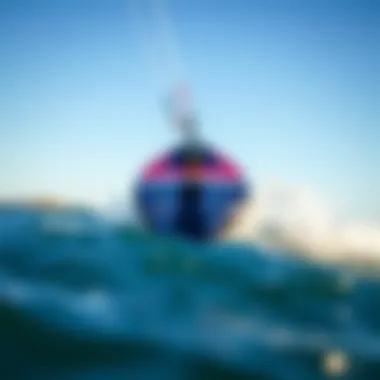
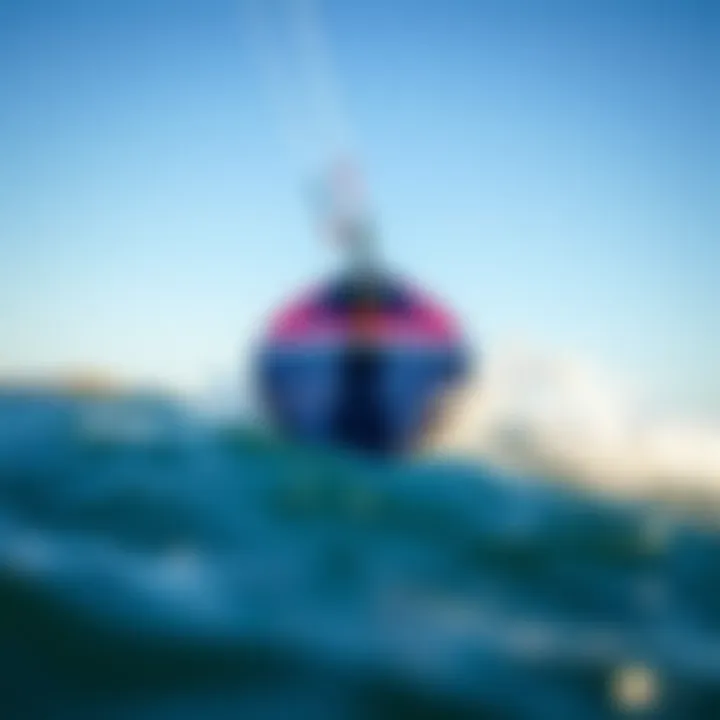
At the heart of efoiling lies the mechanics of foiling, a process that enables the board to lift above the water's surface. When a rider accelerates, the board generates lift through its hydrofoil—similar to an airplane wing. As the board's speed increases, the downward pressure on the wing creates a counteracting upward force, allowing the efoil to rise and maintain altitude above the water.
Key elements to appreciate in this journey of lift include:
- Angle of Attack: Adjusting the angle of the hydrofoil can significantly affect lift. A higher angle offers more lift but can also lead to increased drag.
- Speed: The relationship between speed and lift is non-linear. Riders quickly discover that a fine balance exists between speed and control to ensure smooth rides.
- Weight Distribution: Proper weight distribution on the board is crucial for optimum lift. Leaning too far back or forward can cause instability and even splashes.
The better a rider understands these mechanics, the smoother the ride will likely be, opening up new dimensions of excitement.
Control Mechanisms
Control is paramount when operating an efoil. Unlike traditional kiteboards, where the rider primarily relies on body positioning and kite control, efoils introduce electronic components that actively influence performance.
- Remote Control: Most efoils come with a handheld remote that controls speed. This device can adjust the power sent to the motor, allowing for precise speed control.
- Foil Instability Compensation: Advanced efoils are often equipped with stabilization features that automatically adjust the motor output to counteract sudden shifts in weight.
- Body Positioning: A rider's position on the board remains crucial. Shifting weight forward or back directly impacts the board's balance and the stability of the foil.
Mastering control mechanisms enhances overall maneuverability and makes for a more enjoyable ride.
Power and Battery Life
The performance of an efoil hinges not just on its design but also on its power system. Understanding battery life and the energy dynamics at play is crucial for any kiteboarding enthusiast.
- Battery Capacity: Most efoils use lithium-ion batteries, which offer a balance of weight and longevity. Battery capacity directly influences how long one can ride before needing a recharge. A typical high-quality battery might last anywhere from 60 to 90 minutes, depending on usage.
- Charging Time: Riders should be aware of the charging time as well. Usually, it can take anywhere from a few hours to half a day to charge fully, which means planning ahead for a day out on the water.
- Energy Usage: Different riding styles demand different energy levels. Surfing or cruising generally consumes less power than aggressive maneuvers, for instance. Riders can manage their rides by monitoring their energy usage, ensuring that they don’t run out of juice unexpectedly.
Understanding these operational principles can elevate the experience of any kiteboarder using a flight board efoil, merging technology with the thrill of water sports.
Advantages of Using Flight Board Efoils
The advantages of utilizing Flight Board Efoils in kiteboarding extend beyond simple pleasure in water sports. These modern innovations deliver significant enhancements in speed, maneuverability, and overall user accessibility, redefining how enthusiasts engage with the water. Understanding these benefits is paramount for those looking to elevate their experience.
Enhanced Speed and Maneuverability
Flight Board Efoils are engineered to cut through water like a knife through butter. This design enables riders to achieve higher speeds compared to traditional kiteboards, largely due to the lack of drag from direct water contact. When you’re hovering above the surface, you unveil a new realm of performance. Riders report speeds that, before, were just daydreams, reaching far beyond what conventional boards can achieve.
But speed is only part of the equation. The agility that comes with riding an efoil is compelling. Imagine being able to carve turns with precision or pop up and down with ease without the constant need to battle the throaty waves. This increased maneuverability caters to a wide spectrum of riding styles, accommodating both the timid novice and the adrenaline-pumping expert.
Reduced Water Friction
When we speak about reduced water friction, we're scratching the surface of one of the biggest advantages of the Flight Board Efoil. By lifting off the water, you create an entirely new glide experience. Picture this: instead of wrestling with the waves, you’re smoothly gliding, akin to a bird soaring in the sky. This friction reduction not only allows for smoother rides but also contributes to a more energy-efficient experience.
Thus, with minimized energy loss, you can enjoy longer sessions on the water, whether you’re zipping across the surface or just cruising along with friends. The technology behind efoils essentially enhances hydrodynamics. To sum it up, riders benefit from greater speeds and sustained longer periods of fun without the taxing drain of energy.
Accessibility for All Skill Levels
Accessibility stands as a hallmark of the Flight Board Efoil. This piece of equipment is not just for the daredevils or the pros on the water. In fact, efoils open the door for those just dipping their toes into kiteboarding. The learning curve, although present, is markedly softer. Riders don’t need the same level of strength or skill to keep themselves steady on the board.
Most importantly, novices can achieve that floating sensation and experience the thrill of standing above water without feeling as if they're in over their heads. The approachable nature of Flight Board Efoils means that everyone, regardless of age or skill level, can partake in the excitement of kiteboarding without the steep barriers once necessary.
“Efoiling is like taking the leap into the future of kiteboarding, where everyone gets to be a part of the adventure.”
Challenges of Flight Board Efoils
While the Flight Board Efoil is a remarkable innovation in the realm of water sports, it is not devoid of challenges that enthusiasts must navigate. Understanding these obstacles is critical for anyone considering the transition from traditional kiteboarding to this advanced technology. Let’s explore the key challenges of Flight Board Efoils, including elements like the learning curve, costs, and environmental impacts.
Learning Curve
When it comes to efoiling, the learning curve can be a rocky one. Unlike conventional kiteboarding, where familiar techniques like steering with the wind are paramount, efoiling demands distinct skills that can bewilder many beginners. It might feel as if you’re trying to ride a unicycle on water while juggling flaming torches.
Being able to understand balance and control on the board is essential. Many early adopters of Flight Board Efoils find themselves repeatedly falling during their initial attempts, leading to frustration. Here are a few insights on adapting to the learning curve:
- Patience is necessary: Mastery comes with time and practice. Consistent attempts will build muscle memory, allowing for smoother rides.
- Instructional lessons: Signing up for professional efoiling classes can significantly shorten the learning curve. Expert guidance will highlight techniques that might go unnoticed otherwise.
- Focus on fundamentals: Spend time practicing basic movements before jumping into advanced maneuvers. Gaining confidence with the board will help you feel more in control.
Cost Considerations


Let’s face it – diving into efoiling isn’t a budget-friendly endeavor. The initial investment that comes with the Flight Board Efoil can be a hefty financial commitment for many kiteboarders. Here’s a breakdown of cost considerations:
- Equipment pricing: A typical Flight Board Efoil can range from several thousand to tens of thousands of dollars, depending on the brand and specifications. This price range can deter some enthusiasts.
- Maintenance costs: Keeping your efoil in good shape requires regular maintenance. This can include changing batteries, checking electronics, and inspecting the foil for wear and tear.
- Insurance and storage: It’s wise to consider insurance for your gear. Additionally, you might also think about secure storage solutions to protect your investment during off-seasons.
Purchasing a Flight Board Efoil is more than just parting with cash; it’s an investment in experiences and adventures to come.
Environmental Considerations
As we navigate the delights of efoiling, we must also reckon with potential environmental concerns. It’s a good idea to look at how this technology affects our waters and ecosystems. Here are some points to contemplate:
- Noise pollution: Unlike traditional kiteboarding which operates silently on wind power, efoils are electric-powered. They create noise, potentially disturbing marine life, especially in tranquil areas.
- Battery waste: The batteries used in efoils have a limited lifespan and can contribute to environmental issues if not disposed of correctly. It's crucial for users to implement proper recycling or disposal methods for old batteries.
- Wildlife interference: High-speed foiling can inadvertently disrupt local wildlife, particularly in sensitive habitats where animals thrive. Being respectful of these ecosystems is crucial for maintaining harmony.
"While new technology opens doors to exhilarating experiences, we must remain vigilant stewards of the environment."
In essence, grappling with the aforementioned challenges not only prepares kiteboarders for the efoiling experience but also encourages responsible practices. As kiteboarding enthusiasts embrace this exciting technology, awareness and thoughtful approaches will lead to a more fulfilling and sustainable adventure on the water.
Comparative Analysis with Traditional Kiteboarding
In the world of water sports, kiteboarding has long held a place of honor for its exhilarating blend of skill, technique, and connection to the elements. However, the emergence of efoiling, particularly with the introduction of the Flight Board Efoil, introduces a different dimension altogether. Examining the differences between traditional kiteboarding and efoiling is crucial, not just for enthusiasts but also for instructors and coaches looking to adapt their teaching methods.
Speed and Efficiency
As any seasoned kiteboarder knows, the thrill of speed is intrinsic to the sport. Efoiling radically alters the parameters of how speed is perceived and achieved on water. The Flight Board Efoil can glide across the surface at impressive speeds, often surpassing what can be achieved with traditional kiteboarding setups. This is chiefly due to the buoyancy provided by the hydrofoil, which significantly reduces water resistance. For example, when a kiteboarder reaches a certain speed, the board planes on the surface, creating drag. In contrast, with an efoil, the rider gets lifted above the water, allowing for minimal friction and faster acceleration.
- Efoil Speed Metrics:
- Average efoil speed can reach 25 mph or more.
- Ideal conditions can push speeds even higher.
Understanding these capabilities, kiteboarders may find that integrating efoiling into their skill set can provide new opportunities to refine their speed techniques while enhancing overall performance.
Techniques and Skill Sets Required
Efoiling requires a different set of skills compared to traditional kiteboarding, emphasizing balance and coordination in new ways. Riders need to learn to manage throttle control alongside steering, which is a significant shift from the kite control focus in traditional kiteboarding.
- Key Techniques for Efoiling:
- Body Positioning: Keeping low and centered aids in maintaining balance.
- Throttle Management: Learning to adjust the power smoothly is crucial in preventing nosedives or topple over.
- Turning Mechanism: Techniques differ considerably; efoilers lean more into turns rather than relying solely on edge control.
For instructors, it’s vital to develop a curriculum that effectively transitions traditional kitesurfers to efoilers, emphasizing these contrasts in techniques to aid learning curves.
Equipment Maintenance and Lifespan
When diving into efoils, the maintenance aspect is materially different compared to traditional kiteboards. Efoils typically consist of electronic components alongside mechanical fixtures, which means a different approach to upkeep.
- Efoil Maintenance Considerations:
- Battery Care: Regularly check connections and charge levels to ensure optimal performance.
- Foil Inspection: Regularly inspect for wear, particularly the leading edges which are prone to damage.
- Sealing Components: Ensuring all electronic parts are sealed against water intrusion is essential for longevity.
In contrast, traditional kiteboarding boards and kites generally require less technical maintenance, focusing more on fabric care and occasional hardware checks. Understanding these differences can assist kiteboarding enthusiasts in choosing their next adventure gear wisely.
In sum, comparing efoiling to traditional kiteboarding is crucial for recognizing not only the differences in speed, technique, and equipment maintenance but also the enhancement opportunities they offer. The transition from one to the other can help riders expand their skills and adapt to the evolving dynamics of water sports.
"Kiteboarding is about the connection with the wind; efoiling offers a dance upon the water's surface."
For more information on kiteboarding and efoiling, visit resources like Wikipedia or Britannica.
The insights gained from this comparative analysis can significantly influence how kiteboarding instructors structure their lessons, offering both foundational and advanced techniques tailored to including efoiling in their programs.
Maintenance of Flight Board Efoils
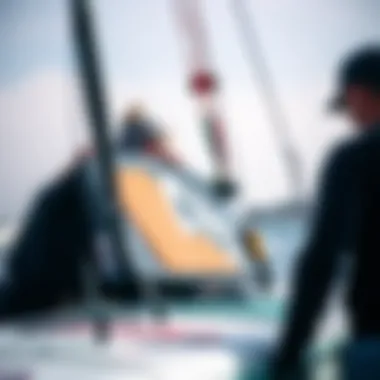
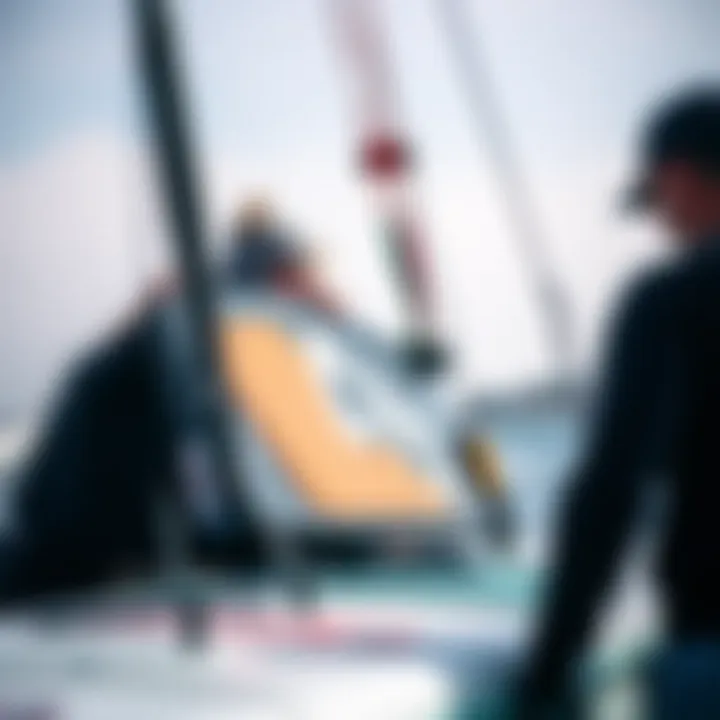
Maintaining a Flight Board Efoil is essential for sustaining its performance and prolonging its lifespan. Just like any high-tech piece of equipment, regular care can make a world of difference. For kiteboarding enthusiasts, understanding maintenance not only ensures your efoil operates efficiently but also enhances your overall riding experience. This section will delve into the vital care procedures and problem-solving strategies that every efoil user should know.
Routine Care Procedures
Routine care for your Flight Board Efoil is straightforward yet crucial. Following these basic procedures will keep your efoil in top shape:
- Clean Thoroughly After Each Use: Saltwater and sand can be particularly harsh on the components of your efoil. After each session, rinse your efoil with fresh water to remove any residue. Take care to clean the electrical components, but avoid soaking the battery compartment.
- Inspect Components Regularly: Check for any signs of wear and tear, especially on the wing, fuselage, and mast. Look for cracks, scratches, or loose fittings that might affect performance. Ensuring everything is secure can prevent more significant issues in the long run.
- Store Properly: After your adventures, store your efoil in a dry, cool place out of direct sunlight. Avoid leaving it in damp or humid environments that may encourage rust or corrosion.
- Battery Care: Always monitor the battery charge and avoid letting it deplete completely. A consistent charging habit extends battery life. Follow the manufacturer's guidelines regarding charging cycles and storage practices.
"Routine maintenance might seem tedious, but it's a breeze compared to facing major repairs later on."
- Check the Propulsion Unit: Listen for any unusual noises while riding. If the propeller isn’t operating smoothly, inspect it for debris or damage, as a well-functioning propulsion unit is critical for effective foiling.
By sticking to these routine procedures, you can enjoy your Flight Board Efoil for many seasons, keeping the spirit of kiteboarding alive and well.
Troubleshooting Common Issues
Even the best of equipment can face hiccups from time to time. Here’s how to handle typical problems you might encounter with your Flight Board Efoil:
- Reduced Speed: If your efoil isn’t achieving expected speeds, first check the battery life. Low power can result in diminished performance. If the battery isn’t the issue, examine the propeller for dirt or debris that might be causing drag.
- Erratic Control: Sudden shifts in control can be alarming. This could be linked to faulty wiring or issues with the remote controller. Always inspect electrical connections and ensure that the controller has adequate charge. Sometimes, resetting the system can resolve connectivity problems.
- Overheating: If the motor is overheating, power down immediately. Let it cool and investigate for blockages in the cooling system. An overheated motor can lead to long-term damage if not addressed promptly.
- Unusual Noises: Strange sounds during operation can be indicative of mechanical failures. Check for loose components that might need tightening, or inspect the propeller for damage.
- Battery Issues: If you notice words in the battery meter acting strangely, ensure that the connectors are secure. If issues persist, consult the manufacturer or a professional for deeper diagnostics.
By actively engaging in routine maintenance and troubleshooting potential issues, kiteboarding enthusiasts can confidently ride the waves, focused more on the thrill of the sport than on worrying about their efoil. Staying proactive can turn your efoil into your trusty companion for years to come.
Future of Efoiling Technology
Efoiling technology is not just a passing trend; it represents a pivotal shift in how kiteboarding enthusiasts approach the sport. As more consumers gravitate towards innovative water sports gear, understanding the future of efoiling will be essential for anyone serious about the craft. This section will delve into
- Innovations on the Horizon
- Potential Market Growth
These elements not only define what is to come but also highlight the promise that efoiling holds for broadening participation and enhancing performance in kiteboarding.
Innovations on the Horizon
The efoiling landscape is ripe for technological advancements that promise to reshape the sport. Innovations are swirling in the air like a summer breeze. Battery technology will likely see the most significant improvements. Current batteries restrict the range and performance of efoils, but advances in lithium-ion and solid-state batteries might lead to lighter options with longer life spans. Think about it: if the weight of the battery is reduced, riders can experience greater agility and efficiency on the water.
Another noteworthy development involves aerodynamic designs. Manufacturers are pushing boundaries to create more streamlined hulls that slice through water with reduced drag. Enhanced control systems are also on the table. Imagine intuitive steering based on a rider's movements, utilizing sensors and artificial intelligence to predict maneuvers. It’s not far off to think that in the near future, a rider's next jump or trick could be digitally assisted!
It's worth mentioning the use of sustainable materials too. As environmental consciousness grows, companies will likely explore eco-friendly composites without sacrificing performance. This intersection of innovation and sustainability is crucial for a sport that inherently relies on nature.
"Embracing eco-materials in construction can help mitigate our carbon footprint while pushing limits in performance," said an industry expert in a recent symposium.
Potential Market Growth
The market for efoiling is heating up like a kettle on the stove. A critical factor is the broadening appeal this form of kiteboarding has, especially to those who may have found traditional methods daunting or inaccessible. Efoiling offers a unique entry point, capturing the interest of newcomers while allowing seasoned riders to elevate their skills.
Though still considered niche, the growth potential is unmistakable. Global markets are projected to expand, driven by increased disposable income and a burgeoning curiosity towards water sports. Regional hotspots, particularly in coastal areas, could become breeding grounds for efoiling enthusiasts.
Interestingly, as efoiling becomes more popular, there could also be an impact on existing kiteboarding culture. The local ecosystems that support large kiteboarding communities might evolve into hybrid hubs, accommodating both traditional kiteboarders and efoilers alike.
As riding styles blend and communities grow, we might witness an evolution in instruction as well. New job opportunities for instructors willing to share their efoiling expertise may arise, making it a steady occupation for kiteboarding coaches looking to diversify their offerings.
In summary, the future of efoiling technology is not just about riding the waves; it's about riding the wave of innovation and market expansion that can redefine what it means to be a kiteboarding enthusiast in this modern era.
Closure: The Evolution of Kiteboarding with Efoiling
The world of kiteboarding is changing rapidly, and the advent of efoiling represents a significant leap in that evolution. In this guide, we've delved into the intricate details of Flight Board efoils, examining how they've reshaped the kiteboarding experience. Understanding the importance of this shift is crucial, as it highlights not just the innovation itself, but also what it means for enthusiasts at all levels.
The Integration of New Technologies
As we consider the integration of new technologies, it's evident that efoiling encapsulates a fusion of creativity and engineering. This new wave of technology brings with it a variety of benefits:
- Enhanced Performance: The propulsion systems in efoils allow riders to achieve speeds that traditional kiteboarding might not facilitate easily, offering a whole new dimension of thrills on the water.
- Increased Accessibility: With electric drive systems, individuals who may not have mastered kite control can still experience the joy of gliding over the waves.
- Eco-friendly Solutions: Efoiling encourages more environmentally conscious practices in water sports, as they tend to have a smaller ecological footprint compared to gas-powered alternatives.
The implications of integrating these technologies into kiteboarding extend far beyond just performance. They introduce a new ethos of community and inclusivity, inviting newcomers into the folds of the sport while challenging seasoned riders to adapt and enhance their techniques.
"Efoiling is not merely a fashion statement in water sports; it is a rewriting of the rules that govern how we interact with the sea."
Moreover, as we venture into the future of efoiling, constant innovations await on the horizon. Various manufacturers are exploring ways to refine battery life, improve material durability, and develop smarter controls to make the experience even more user-friendly. This is an exciting time in water sports, with kiteboarding at the forefront of that transformation, paving the way for a more dynamic, engaging, and diverse sporting community.






